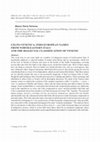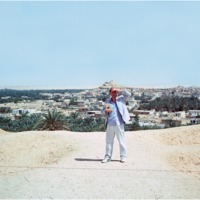Books by Blanca María Prósper

by Ralph Haussler, Ralph Haeussler, Anthony C King, Audrey Ferlut, Daphne Nash Briggs, Roger S O Tomlin, Alfred Schäfer, Blanca María Prósper, Cristina Girardi, Marjeta Šašel Kos, Vojislav Filipovic, Fernando Fernández Palacios, Alessandra Esposito, and Werner Petermandl ed. by R. Haeussler and A. C. King. Aberystwyth 2017.
What is Celtic religion? And does it survive into the Roman period? This multi-authored volume ex... more What is Celtic religion? And does it survive into the Roman period? This multi-authored volume explores the 'Celtic' religions in pre-Roman and Roman times. It book brings together new work, from a wide range of disciplinary vantages, on pre-Christian religions in the Celtic-speaking provinces of the Roman Empire. The twenty-six chapters are the work of international experts in the fields of ancient history, archaeology, linguistics, epigraphy and Celtic studies. It is fully illustrated with b&w and colour maps, site plans, photographs and drawings of ancient inscriptions and images of Romano-Celtic gods.
The collection is based on the thirteenth workshop of the F.E.R.C.AN. project (Fontes epigraphici religionum Celticarum antiquarum), which was held from the 17th to the 19th October 2014 in Lampeter, Wales.
with F. Villar, C. Jordán and P. Fernández.
This is a study of the only Celtiberian document written on lead, seemingly a business letter.
W... more This is a study of the only Celtiberian document written on lead, seemingly a business letter.
With two addenda, resp. on the reflexes of CC. *dubu-o- "dark" in Old irish, Galatian and Hispanic onomastics, and the Celtiberian notation of syllabic codas
Papers by Blanca María Prósper
Proceedings of the 34th Annual UCLA Indo-European Conference, 2024
This work aims to clarify a number of hitherto insufficiently explained issues related to two Cis... more This work aims to clarify a number of hitherto insufficiently explained issues related to two Cisalpine Celtic funerary inscriptions on stone, respectively written in Lepontic (Vergiate, Transpadana) and Cisalpine Gaulish (Todi, Umbria). They have one interesting trait in common: the funerary rituals are seemingly divided into two different parts, possibly alluding to two different stages of the obsequies. The etymologies of the four direct objects mentioned will prove instrumental to the understanding of funerary practice in Celtic Italy. Some phonetic and morphological aspects of the studied forms will also illuminate some aspects of the dialectal relatedness of Lepontic and Gaulish.

Voprosy Onomastiki, 2024
This work tries to cast some light on a number of indigenous names of northeastern Italy. It spec... more This work tries to cast some light on a number of indigenous names of northeastern Italy. It specifi cally addresses a selected number of names from Brixia and its environment, which lies in the west of Venetia et Histria, and close to the border of the Gallia Transpadana, covering an area that runs from the Oglio to the Adige rivers, around the Garda Lake. Most of these names have one thing in common: they are hardly ever found anywhere else, and, as a consequence, they have obtained a label: Jürgen Untermann called them Brescianisch, thus tacitly paving the way for considering them as a trace of an independent, unknown and unclassifi ed dialect. That these names are not attested outside this area is not necessarily diagnostic of their not being Celtic or Italic, though the path leading to their classifi cation may prove winding and indirect. Their etymology and attribution to either Celtic or Venetic will be thoroughly discussed. The study of the Venetic name comes to confi rm the evolution of the complex superlative suffi x *-is-(H)o->-izʊmo->-īmo-is common to Sabellic and Venetic, where only the name provided evidence for this change. Some misidentifi ed or overlooked derivational and compositional patterns are addressed, such as the superlatives in-umus, the Celtic compounds in-gassi-and the probably both Italic and Celtic compounds whose fi rst member is an Indo-European root-noun *ḱlu-'hearing.' The personal names
Rivista Italiana di Linguistica e Dialettologia (only first page available for legal reasons), 2024

Voprosy Onomastiki, 2023
The so-called “Lugano alphabet” is a northern Italian script that derives from the Etruscan alph... more The so-called “Lugano alphabet” is a northern Italian script that derives from the Etruscan alphabet. It was used to write Celtic texts belonging to Lepontic, uncovered in the centre of the Gallia Transpadana (Lombardy and Ticino in southern Switzerland), ranging from the 6th c. to the 1st c. BC, and a later variety called Cisalpine Gaulish, whose earliest texts date from the 4th c. BC, and which represents a later wave of immigrants/invaders. Their dialect is distinguished from the former by a few morphological traits. While the Lugano script is deciphered in its entirety, some pending issues remain as to the actual use of some of its letters. This work will address the problem of the “butterfly sign,” a letter transliterated as <ś>, showing different shapes and going back to Greek san, for which a high number of synchronic values and etymological origins has been proposed
Rivista Italiana di Linguistica e dialettologia, 2022
This is a study of the Tabula Veliterna, a legal document found in Velletri and referring to the ... more This is a study of the Tabula Veliterna, a legal document found in Velletri and referring to the safeguard of the goods of the goddess Declona and the measures to be taken in case of theft or profanation thereof. I shall undertake a radically different approach to syntax, phonetics and morphology. In turn, some of the conclusions may have some bearing on our conception of Sabellic phonetics and phonology.
Desperta ferro. Arqueología e historia, 2023
El origen de la familia celta sigue siendo enigmático en el día de hoy, hasta el punto de que exi... more El origen de la familia celta sigue siendo enigmático en el día de hoy, hasta el punto de que existen tres hipótesis contrapuestas sobre el problema. Este artículo revisa su verosimilitud desde el punto de vista de un lingüista y aborda el problema de la definición de celticidad y el parentesco inmediato de las lenguas celtas entre sí.
Journal of Language Relationship, 2022
On the strength of both recent discoveries concerning the use of the Latin alphabet in different ... more On the strength of both recent discoveries concerning the use of the Latin alphabet in different places of Central Hispania to write official documents in Celtiberian and the new readings of indigenous names on inscriptions belonging to Latin, not Celtiberian, epigraphy, some novel reflections on Celtiberian phonology are in order. Epigraphic and linguistic considerations in turn lead to a refinement in the delimitation of Hispano-Celtic regions. These attend to dialectal differences and to the emergence and stabilisation of scribal habits. New etymologies for some hitherto uninterpreted or even misinterpreted personal names are put forward. Some of these have the comparative advantage of matching inherited Celtic forms surviving in Insular Celtic and Gaulish.

Voprosy Onomastiki, 2022
The linguistic study of Celtic divinities attested on Latin inscriptions has proved instrumental ... more The linguistic study of Celtic divinities attested on Latin inscriptions has proved instrumental in disclosing a number of facts about ancient religion, the relationship with the Roman rule, and the spread of indigenous or syncretic cults. In fact, minor divinities were worshipped on a local basis only, but even under such unfavourable circumstances they managed to become partly integrated in the religious system of the Roman Empire: they acted in the sphere of the higher gods for a time before they vanished for ever, and they must have been much more common than our fragmentary sources suggest. Crucially, the study of their names also provides priceless clues about the early stages of Celtic phonology and morphology, it also helps illuminate insufficiently known aspects of the evolution of Continental and Insular Celtic and their interaction with Latin. In this work, the authors focus on several hitherto misinterpreted Celtic divine names from Britannia (MEDOCIO, ARNOMECIE, BRACIACAE, ARCIACONI, COROTIACO) and Gaul (MEDVTONI, COBRANDIAE, CENTONDI, ROQVETIO, SINQVATI) and try to test their relative importance for Indo-European language reconstruction, distant cultural relationship of ancient populations, ancient religion with special attention to the interaction of major Roman divinities with minor Celtic ones, Latin and Celtic phonetics and morphology, loan phonology and the spread and adaptation of the Latin alphabet to write texts in the indigenous Celtic languages and foreign names in Latin epigraphy.
Studia Philologica Valentina, anejo 2, 2021
LITERATURA gRIEgA FRAnCESC CASADESúS bORDOy: La alegoría socrático-platónica del carro alado en e... more LITERATURA gRIEgA FRAnCESC CASADESúS bORDOy: La alegoría socrático-platónica del carro alado en el Fedro y su correlato en Parménides y en la Kaṭha
Curiositas nihil recusat. Studia Isabel Moreno Ferrero dicata, Universidad de Salamanca, 2021
The recent publication of a new Lusitanian inscription uncovered in Plasencia (Cáceres) is bound ... more The recent publication of a new Lusitanian inscription uncovered in Plasencia (Cáceres) is bound to have an enormous impact on Lusitanian studies, since it has confirmed the correctness of the doubtful reading labbo in the rock inscription of Cabeço das Fráguas. This 'new' divine name has far-reaching consequences for Lusitanian nominal inflection, specifically the morphs of the dative and locative endings. In accordance with this, new conclusions can be drawn regarding the dialectal attribution of Lusitanian in the Indo-European language family that definitely separate it from Celtic and approach it to Italic
Zeitschrift für Celtische Philologie, 2021
In der alten Siedlung von Virovesca im Südwesten des Gebietes der Autrigones ist unlängst eine ne... more In der alten Siedlung von Virovesca im Südwesten des Gebietes der Autrigones ist unlängst eine neue keltiberische tessera hospitalis zu Tage getreten. Diese ist in keltiberischer Sprache und lateinischem Alphabet geschrieben und bietet den ersten Beleg für die Form *gortā ‚Stadt', von der das häufige Adjektiv kortika abgeleitet ist. In diesem Beitrag wird versucht, eine Reihe von Punkten zur keltiberischen Etymologie und Morphologie zu klären und eine Stütze für die Ansicht zu liefern, daß Familien und Städte, die Gastfreundschaft gewähren, im Genitiv stehen können, dagegen ausschließlich Städte alternativ auch mit Hilfe adjektivischer Ableitungen erwähnt werden können.










Uploads
Books by Blanca María Prósper
The collection is based on the thirteenth workshop of the F.E.R.C.AN. project (Fontes epigraphici religionum Celticarum antiquarum), which was held from the 17th to the 19th October 2014 in Lampeter, Wales.
With two addenda, resp. on the reflexes of CC. *dubu-o- "dark" in Old irish, Galatian and Hispanic onomastics, and the Celtiberian notation of syllabic codas
Papers by Blanca María Prósper
The collection is based on the thirteenth workshop of the F.E.R.C.AN. project (Fontes epigraphici religionum Celticarum antiquarum), which was held from the 17th to the 19th October 2014 in Lampeter, Wales.
With two addenda, resp. on the reflexes of CC. *dubu-o- "dark" in Old irish, Galatian and Hispanic onomastics, and the Celtiberian notation of syllabic codas